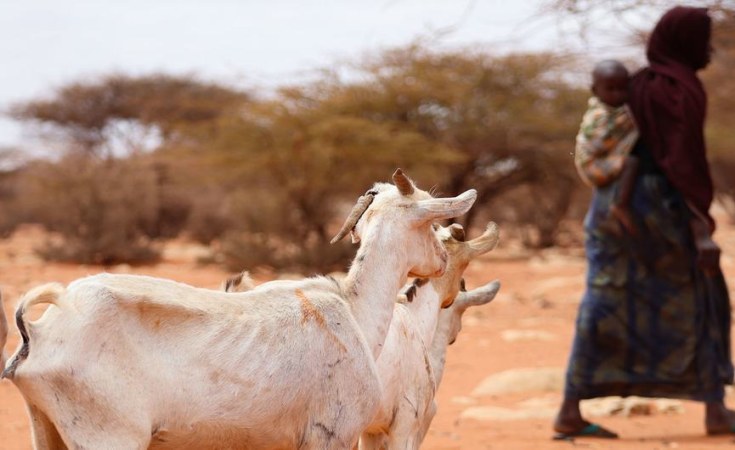As the international community gathers in New York this week for the Horn of Africa High Level Pledging Conference, we urge global donors to address the impact of the climate injustice taking place in the region by making the financial pledges required to fully fund the humanitarian response and help address immediate and long-term needs across Ethiopia, Kenya and Somalia, where millions of people are trapped in a devastating cycle of hunger and displacement.
Increasingly frequent, severe, and pervasive climate-fuelled disasters, including the longest and most severe drought on record in the Horn of Africa, are affecting communities in catastrophic ways. The drought, in convergence with other shocks such as unusually high food and commodity prices and ongoing conflicts has destroyed lives and livelihoods and driven record levels of humanitarian needs.
In 2022 alone, a recent UN report suggests that an estimated 43,000 people died as a result of the drought in Somalia, half of them most likely children under the age of five, and 5 million people were internally displaced in Kenya, Ethiopia, and Somalia, including 2.3 million by disasters and 2.7 million by conflicts and violence. Over 35 million people require urgent assistance across the three countries, with food and water insecurity, health, protection, and education needs among the most severe, especially for groups with different vulnerabilities, such as women, children, and the elderly. An estimated 23.8 million people currently face hunger in the region. Among them, we know that women and girls are the ones who eat last and least, and we are especially concerned by the estimated 1.9 million children that continue to face life-threatening, severe acute malnutrition.
When donors met for last year's High-Level Roundtable on the Horn of Africa Drought, we sounded the alarm that 14 million people were on the verge of starvation and called for urgent additional funds to be allocated to the humanitarian response to prevent the worst possible outcomes. Unfortunately, pledges generated during that event did not match the severity of the situation. With insufficient funds to address the needs, by October 2022, 21 million people were experiencing crisis levels of hunger and parts of Somalia were projected to face famine. It was only late in the year that a considerable top-up of new funds was provided, allowing humanitarian actors to rapidly scale up their response and prevent famine in Somalia.
Yet people are still suffering and the death toll continues to rise in the Horn of Africa. Dry conditions continue to affect most areas, while localised heavy rains have led to dangerous flash floods in some parts of Ethiopia and Somalia, as the parched ground cannot absorb water. Whilst famine has thus far been prevented, it remains a likely scenario. In Kenya, the latest IPC data projects an unprecedented deterioration of the situation with 1.2 million people likely to face emergency levels of food insecurity by June 2023. It is critical for humanitarian actors to continue scaling up their response at this time, but funds have already started depleting, and breaks in the funding pipeline are forcing organisations to scale down assistance to people in need. We cannot allow last year's scenario to repeat itself. If funds remain unpredictable, insufficient, and come late each year, the region will be trapped in a cycle of hunger and displacement causing unnecessary suffering for years to come.
The international community must accept responsibility for their role in contributing to this crisis and take action to address one of the biggest climate injustices of our time. New evidence by a group of climate scientists from World Weather Attribution shows that without the human-driven climate crisis the world is facing today, the current historic drought that continues to fuel hunger in the Horn of Africa would have been about 100 times less likely to occur. The combined carbon emissions of Somalia, Ethiopia and Kenya reach a mere 0.1% of the global total, whereas the carbon emissions of the G20 countries account for 76%. In other words, people in the Horn of Africa are suffering the consequences of a climate emergency they did not create.
People will continue to face recurrent hunger crises if the countries in the region are not supported with coordinated, long-term, and scaled-up investments that can address immediate needs while contributing to resilience and climate adaptation. We therefore call on donors to take immediate steps to break the cycle of short-term, inadequate funding to end preventable deaths and suffering in the Horn of Africa.
We, the undersigned organisations, specifically urge global donors to:
Make substantive, additional financial pledges to fully fund the Humanitarian and Drought Response Plans for Ethiopia, Kenya, and Somalia in the first half of 2023 on a no regrets basis. The combined plans are currently only 23% funded, leaving a shortfall of over $5 billion. Funds should be front-loaded and primarily allocated directly to International, National, and Local NGOs that have the capacity to respond quickly and with greater access to hard-to-reach areas, including to women-led organisations that are better equipped to address the gendered dimensions of the hunger crisis.
Ensure that funds mobilised are flexible, multi-year, and predictable, allowing humanitarian assistance to reflect the protracted nature of the crisis by addressing immediate needs while also building communities' resilience to inevitable future shocks.
Ensure a balanced distribution of resources across sectors to enable humanitarian actors to address the full range of humanitarian needs affecting communities in the Horn of Africa, including traditionally neglected sectors such as protection and education.
Increase the transparency of financial pledges by releasing detailed disbursement plans and ensuring timely and accurate reporting to make it easier for humanitarian actors to plan, coordinate, and implement an effective response.
Encourage national governments to increase their national budgets for drought resilience and emergency response to protect the most vulnerable children, their families and communities with lifesaving assistance.


